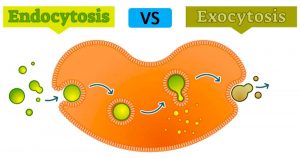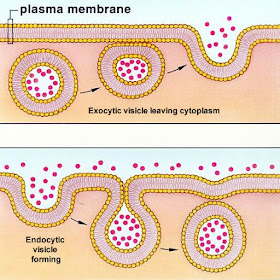Endocytosis and exocytosis are the processes by which cells move materials into or out of the cell that is too large to pass directly through the lipid bilayer of the cell membrane. Large molecules, microorganisms, and waste products are some of the substances that move across the cell membrane through exocytosis and endocytosis.
Why is bulk transport important for cells?
Cell membranes are semi-permeable, meaning that they allow certain small molecules and ions to passively diffuse through them. Other small molecules can enter or leave the cell through carrier proteins or channels. But there are materials that are too large to pass through the cell membrane using these methods. There are times when a cell will need to engulf a bacterium or release a hormone. It is during these cases that bulk transport mechanisms are needed. Endocytosis and exocytosis are the bulk transport mechanisms used in eukaryotes. Since these transport processes require energy, they are known as active transport processes.
Vesicular function in endocytosis and exocytosis.
During bulk transport, larger substances or large packages of small molecules are transported across the cell membrane, also known as the plasma membrane, by means of vesicles; think of vesicles as little sacs of the membrane that can fuse with the cell membrane.
Cell membranes are composed of a lipid bilayer. The walls of the vesicles are also made up of a lipid bilayer, so they are capable of fusing with the cell membrane. This fusion between the vesicles and the plasma membrane facilitates bulk transport both in and out of the cell.
What is endocytosis? Endocytosis definition and purposes
Endocytosis is the process by which cells take in substances from outside the cell by engulfing them in a vesicle. These can include things like nutrients to support the cell or pathogens that the immune cells gobble up and destroy. Endocytosis occurs when a portion of the cell membrane folds back on itself, surrounding the extracellular fluid and various molecules or microorganisms. The resulting vesicle breaks apart and is transported into the cell.
Endocytosis serves many purposes, including:
- Take in nutrients for cell growth, function, and repair: Cells need materials like proteins and lipids to function.
- The capture of pathogens or other unknown substances that can endanger the body: When the immune system identifies pathogens such as bacteria, immune cells engulf them to destroy them.
- Disposal of old or damaged cells: Cells must be disposed of safely when they stop working properly to prevent damage to other cells. These cells are removed by endocytosis.
Types of endocytosis
There are two types of endocytosis: phagocytosis and pinocytosis.
- Phagocytosis
Phagocytosis, also known as cell ingestion, is the process by which cells internalize large cells or particles, such as damaged cells and bacteria. Within the human body and in other mammals, phagocytosis is the way immune cells engulf and destroy dangerous microorganisms or toxic compounds. Macrophages and neutrophils, types of white blood cells, are the two main phagocytes. These white blood cells are responsible for removing aged and damaged cells, as well as killing infectious microorganisms.
- Pinocytosis
Pinocytosis, also known as cell drinking, is common in animal and plant cells. During pinocytosis, the cell takes up substances from the extracellular fluid that it needs to function. These include things like water and nutrients. Receptor-mediated endocytosis is a specialized type of pinocytosis. During receptor-mediated endocytosis, macromolecules bind to receptors along the surface of the cell’s plasma membrane. Cholesterol uptake is an example of receptor-mediated endocytosis.
The steps of endocytosis.
The following is a summary of the basic steps of the two types of endocytosis.
1. Phagocytosis:
- A particle or substance binds to receptors on the cell surface, stimulating the release of pseudopods (cytoplasm-filled extensions of the plasma membrane).
- The pseudopodia surround the object until their membranes fuse, forming a phagocytic vesicle.
- The phagocytic vesicle detaches from the cell membrane and enters the cell.
- The phagocytic vesicle fuses with lysosomes, which recycle or destroy the contents of the vesicle.
2. Pinocytosis:
- The molecules bind to receptors located along the surface of the cell membrane.
- The plasma membrane folds, forming a pinocytic vesicle that contains the molecules and extracellular fluid.
- The pinocytic vesicle detaches from the cell membrane inside the cell.
- The vesicle fuses with the first endosomes where the contents inside are sorted.

Example of endocytosis
Macrophages are a type of white blood cell that plays a central role in protecting mammals against pathogens such as bacteria and viruses. When a macrophage comes into contact with a virus, say a cold virus in the bloodstream, it can bind to the cell surface of the virus.
The macrophage will then form a vesicle around the virus, ingesting it completely. The vesicle then travels to the cytosol and fuses with the lysosome, where the virus is broken down. Some viruses replicate by “tricking” host cells into endocytosing them, at which point the virus hijacks the cell and tells it to replicate the virus genome and capsid.
What is exocytosis? Exocytosis definition and purposes
Exocytosis is the process by which cells move materials from inside the cell into the extracellular fluid. Exocytosis occurs when a vesicle fuses with the plasma membrane, allowing its contents to be released outside the cell.
Exocytosis has the following purposes:
- Removal of toxins or waste products from within the cell: Cells create waste or toxins that must be removed from the cell to maintain homeostasis. For example, in aerobic respiration, cells produce the waste products carbon dioxide and water during the formation of ATP. Carbon dioxide and water are removed from these cells by exocytosis.
- Facilitate cell communication: Cells create signalling molecules such as hormones and neurotransmitters. They are delivered to other cells upon their release from the cell through exocytosis.
- Facilitate cell membrane growth, repair, signalling, and migration: When cells take in materials from outside the cell during endocytosis, they use lipids and proteins from the plasma membrane to create vesicles. When certain exocytotic vesicles fuse with the cell membrane, they replenish the cell membrane with these materials.
Types of exocytosis
- Regulated exocytosis
Most exocytotic vesicles contain substances created within the endoplasmic reticulum for use elsewhere in the body, such as neurotransmitters or hormones. These molecules then pack inside a membrane layer called a vesicle. Once excreted from the endoplasmic reticulum, these vesicles are transported to the Golgi apparatus (also known as the Golgi complex) for further modification.
The molecules are then repackaged into a vesicle that makes its way to the plasma membrane. The release of these molecules from the cell is called regulated exocytosis because the expulsion of the materials is controlled or regulated by extracellular signals that cause membrane depolarization.
- Constitutive exocytosis
Constitutive exocytosis, by contrast, does not require any extracellular signals. Most of the molecules that travel to the plasma membrane do so through this pathway.
After exocytosis, some exocytotic vesicles are incorporated into the plasma membrane (full vesicle fusion), while others return to the interior of the cell after their contents have been released (this is called the “kiss and run” pathway). Others remain attached to the membrane, where they can be used multiple times (the “kiss and stay” pathway).
The steps of exocytosis
Below is a summary of the basic steps of exocytosis.
- A vesicle forms, typically within the endoplasmic reticulum and Golgi apparatus or early endosomes.
- The vesicle travels to the cell membrane.
- The vesicle fuses with the plasma membrane, during which the two bilayers fuse.
- The contents of the vesicle are released into the extracellular space.
- The vesicle fuses with or separates from the cell membrane.
Example of exocytosis
Let’s take the macrophage that we discussed in our endocytosis example. Once the white blood cell has engulfed a foreign pathogen, eliminate it, certain parts of the pathogen are no longer needed. The macrophage gets rid of this waste material through exocytosis, during which vesicles transport unwanted pathogenic material.

